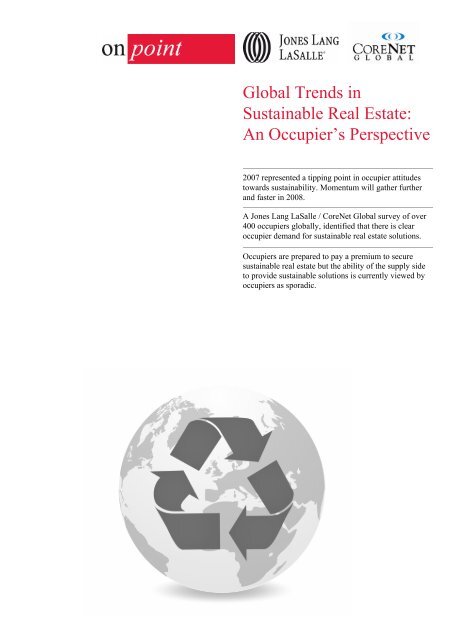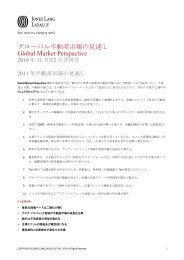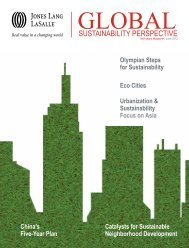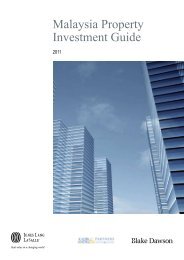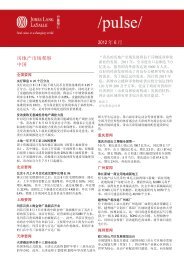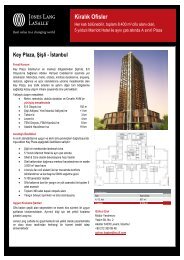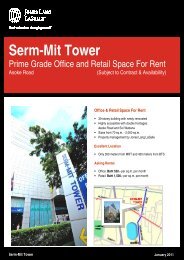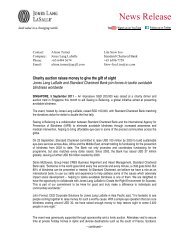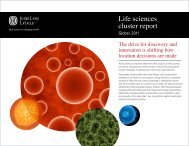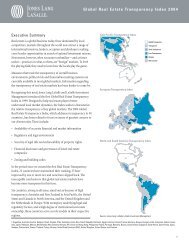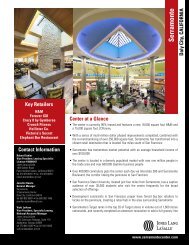Global Trends in Sustainable Real Estate - Jones Lang LaSalle
Global Trends in Sustainable Real Estate - Jones Lang LaSalle
Global Trends in Sustainable Real Estate - Jones Lang LaSalle
You also want an ePaper? Increase the reach of your titles
YUMPU automatically turns print PDFs into web optimized ePapers that Google loves.
<strong>Global</strong> <strong>Trends</strong> <strong>in</strong><br />
Susta<strong>in</strong>able <strong>Real</strong> <strong>Estate</strong>:<br />
An Occupier’s Perspective<br />
2007 represented a tipp<strong>in</strong>g po<strong>in</strong>t <strong>in</strong> occupier attitudes<br />
towards susta<strong>in</strong>ability. Momentum will gather further<br />
and faster <strong>in</strong> 2008.<br />
A <strong>Jones</strong> <strong>Lang</strong> <strong>LaSalle</strong> / CoreNet <strong>Global</strong> survey of over<br />
400 occupiers globally, identified that there is clear<br />
occupier demand for susta<strong>in</strong>able real estate solutions.<br />
Occupiers are prepared to pay a premium to secure<br />
susta<strong>in</strong>able real estate but the ability of the supply side<br />
to provide susta<strong>in</strong>able solutions is currently viewed by<br />
occupiers as sporadic.
<strong>Global</strong> <strong>Trends</strong> <strong>in</strong> Susta<strong>in</strong>able <strong>Real</strong> <strong>Estate</strong>: An Occupier’s Perspective – February 2008<br />
Introduction<br />
Look<strong>in</strong>g back, one theme resonates <strong>in</strong> the demand side of the<br />
property <strong>in</strong>dustry dur<strong>in</strong>g 2007: susta<strong>in</strong>ability. The year saw a<br />
steady growth of <strong>in</strong>terest <strong>in</strong> and attention to the contribution of<br />
corporate real estate to susta<strong>in</strong>ability and corporate social<br />
responsibility (CSR) commitments. As we enter 2008, most<br />
major corporates now have public susta<strong>in</strong>ability statements.<br />
Aga<strong>in</strong>st this back-drop they are also beg<strong>in</strong>n<strong>in</strong>g to pursue<br />
susta<strong>in</strong>able solutions <strong>in</strong> both new and exist<strong>in</strong>g real estate<br />
portfolios.<br />
Susta<strong>in</strong>ability is thus firmly on the corporate agenda. But the<br />
views of corporate occupiers towards susta<strong>in</strong>able real estate<br />
are not widely known. This brief<strong>in</strong>g paper addresses this by<br />
draw<strong>in</strong>g upon the results obta<strong>in</strong>ed from a global survey of over<br />
400 corporate occupiers, conducted jo<strong>in</strong>tly by <strong>Jones</strong> <strong>Lang</strong><br />
<strong>LaSalle</strong> and CoreNet <strong>Global</strong> at CoreNet Summits <strong>in</strong> S<strong>in</strong>gapore,<br />
Denver, Melbourne and London dur<strong>in</strong>g 2007. The aim of the<br />
survey was to gauge corporate awareness, to understand the<br />
key issues driv<strong>in</strong>g susta<strong>in</strong>ability <strong>in</strong> real estate, and to <strong>in</strong>vestigate<br />
some of the perceptions that may be shap<strong>in</strong>g corporate action<br />
and therefore real estate demand.<br />
The views expressed by occupiers and their advisers through<br />
this survey confirm that susta<strong>in</strong>ability reached a tipp<strong>in</strong>g po<strong>in</strong>t <strong>in</strong><br />
2007. The corporate momentum beh<strong>in</strong>d susta<strong>in</strong>ability and CSR<br />
will further <strong>in</strong>tensify over the next twelve months and will<br />
generate real and consistent occupier demand for susta<strong>in</strong>able<br />
real estate across all markets. The ability of the supply side <strong>in</strong><br />
these markets to address such demands is, as occupiers have<br />
identified, presently sporadic at best and needs to be urgently<br />
addressed.<br />
Figure 1: The circle of blame.<br />
Occupiers<br />
“We would like to have more<br />
susta<strong>in</strong>able build<strong>in</strong>gs but there<br />
is too little choice”<br />
Investors<br />
“We would fund susta<strong>in</strong>able and<br />
efficient build<strong>in</strong>gs but there is no<br />
occupier demand for them”<br />
Constructors<br />
“We can build susta<strong>in</strong>able<br />
efficient build<strong>in</strong>gs but<br />
developers don’t ask for them”<br />
Developers<br />
“We would ask for susta<strong>in</strong>able<br />
build<strong>in</strong>gs but the <strong>in</strong>vestors won’t<br />
pay for them”<br />
These results provide a challenge to the cycle of blame (Figure<br />
1) that has typically constra<strong>in</strong>ed the development of susta<strong>in</strong>able<br />
real estate solutions throughout the world. 1 They contradict the<br />
notion that susta<strong>in</strong>able real estate is not commercially attractive<br />
to <strong>in</strong>vestors and developers on account of a paucity of occupier<br />
demand. There is pent up demand for susta<strong>in</strong>able real estate<br />
amongst major corporate occupiers globally, and those on the<br />
supply side that are able to present <strong>in</strong>novative and effective<br />
solutions are most likely to profit as the decade draws to a<br />
close.<br />
3 Occupier Perspectives<br />
on Susta<strong>in</strong>able <strong>Real</strong><br />
<strong>Estate</strong><br />
Three clear occupier views emerge across the globe. Although<br />
the strength of response varies from region to region, <strong>in</strong> general<br />
the same op<strong>in</strong>ions and issues characterise corporate occupiers<br />
irrespective of geography.<br />
1. Susta<strong>in</strong>ability is not for tomorrow’s agenda. It is a<br />
critical CRE issue right here, right now.<br />
As Figure 2 shows, 47% of global respondents <strong>in</strong>dicated that<br />
susta<strong>in</strong>ability was already a critical issue to them, with a further<br />
quarter of all respondents ma<strong>in</strong>ta<strong>in</strong><strong>in</strong>g that susta<strong>in</strong>ability will<br />
become a critical issue to them over the short term, that is<br />
with<strong>in</strong> two years.<br />
There is however clear variance across the globe <strong>in</strong> the pace at<br />
which susta<strong>in</strong>ability is becom<strong>in</strong>g a critical Corporate <strong>Real</strong> <strong>Estate</strong><br />
(CRE) issue (Table 1). EMEA is the region where the issue has<br />
taken strongest hold, most quickly. 60% of EMEA respondents<br />
regard susta<strong>in</strong>ability as a critical issue now, compared with 50%<br />
of Australasian respondents. In contrast, <strong>in</strong> Asia only 40% of<br />
respondents saw susta<strong>in</strong>ability as be<strong>in</strong>g critical right now.<br />
Furthermore even the short-term perspective was less evident<br />
<strong>in</strong> Asia than other global regions, with a quarter of all<br />
respondents see<strong>in</strong>g susta<strong>in</strong>ability as be<strong>in</strong>g only a medium term<br />
(three to five year) issue.<br />
1 Orig<strong>in</strong>ally conceived and published by Environmental Governance, now<br />
Upstream.<br />
COPYRIGHT © JONES LANG LASALLE IP, INC. 2007. All rights reserved. 2
<strong>Global</strong> <strong>Trends</strong> <strong>in</strong> Susta<strong>in</strong>able <strong>Real</strong> <strong>Estate</strong>: An Occupier’s Perspective – February 2008<br />
Figure 2: Expectations as to when susta<strong>in</strong>ability will<br />
become a critical bus<strong>in</strong>ess and CRE issue.<br />
Number of respondents<br />
180<br />
160<br />
140<br />
120<br />
100<br />
80<br />
60<br />
40<br />
20<br />
0<br />
It's already<br />
critical<br />
With<strong>in</strong> 1-2<br />
years<br />
With<strong>in</strong> 3<br />
years<br />
With<strong>in</strong> 5<br />
years<br />
More than 5<br />
years<br />
Time until susta<strong>in</strong>ability becomes critical bus<strong>in</strong>ess issue<br />
Table 1: When will susta<strong>in</strong>ability be a critical bus<strong>in</strong>ess<br />
issue to corporate real estate?<br />
EMEA<br />
North<br />
America<br />
Asia Australasia<br />
Critical Now 62% 44% 42% 52%<br />
Critical with<strong>in</strong> 1- 2 years 23% 35% 20% 23%<br />
This is likely due to the diversity of property market cycles<br />
with<strong>in</strong> the Asia region and difference <strong>in</strong> susta<strong>in</strong>ability drivers<br />
across these markets. In addition, the Asia survey was<br />
undertaken <strong>in</strong> March 2007, and susta<strong>in</strong>ability is an issue that<br />
experienced significant growth <strong>in</strong> momentum throughout the<br />
year right across the region.<br />
We are see<strong>in</strong>g a significant push towards susta<strong>in</strong>ability <strong>in</strong> many<br />
countries <strong>in</strong> Asia. Ch<strong>in</strong>a, India and S<strong>in</strong>gapore are three<br />
countries attempt<strong>in</strong>g to improve susta<strong>in</strong>able real estate<br />
development through revis<strong>in</strong>g standards and policies. In<br />
S<strong>in</strong>gapore, the government is be<strong>in</strong>g able to drive susta<strong>in</strong>ability<br />
effectively and strongly due to its small size and culture. While<br />
the more mature S<strong>in</strong>gapore market is mak<strong>in</strong>g <strong>in</strong>-roads <strong>in</strong><br />
commercialis<strong>in</strong>g susta<strong>in</strong>ability, there is noth<strong>in</strong>g <strong>in</strong> S<strong>in</strong>gapore<br />
equivalent <strong>in</strong> scale and scope to the major susta<strong>in</strong>able<br />
developments go<strong>in</strong>g on <strong>in</strong> Ch<strong>in</strong>a and India now. India has one<br />
of the first LEED rated build<strong>in</strong>gs <strong>in</strong> Asia and Olympia<br />
Technology Park <strong>in</strong> Chennai, which has achieved a LEED Gold<br />
Rat<strong>in</strong>g, has been identified as the world’s largest green<br />
build<strong>in</strong>g. 2 Ch<strong>in</strong>a is build<strong>in</strong>g the world’s first eco-city <strong>in</strong> Dongtan,<br />
anticipated for completion <strong>in</strong> 2010. At the same time, there are<br />
also other large-scale susta<strong>in</strong>able developments enter<strong>in</strong>g the<br />
plann<strong>in</strong>g stage <strong>in</strong> Ch<strong>in</strong>a.<br />
2 LEED is a Green Build<strong>in</strong>g Rat<strong>in</strong>g System developed by the US Green Build<strong>in</strong>g<br />
Council which provides a suite of standards for environmentally susta<strong>in</strong>able<br />
construction.<br />
Never<br />
3 COPYRIGHT © JONES LANG LASALLE IP, INC. 2007. All rights reserved.<br />
Those occupiers at the vanguard of susta<strong>in</strong>ability are typically<br />
global <strong>in</strong> orientation and are appraised on a global basis. They<br />
are br<strong>in</strong>g<strong>in</strong>g demands for susta<strong>in</strong>able real estate to the fore<br />
across Asia. Develop<strong>in</strong>g markets have a significant opportunity<br />
to cater to these requirements by <strong>in</strong>troduc<strong>in</strong>g susta<strong>in</strong>ability<br />
<strong>in</strong>itiatives <strong>in</strong> new build<strong>in</strong>gs due to the higher level of new<br />
development compared to exist<strong>in</strong>g stock on the market.<br />
Develop<strong>in</strong>g markets <strong>in</strong> Asia have a real opportunity to<br />
implement susta<strong>in</strong>ability <strong>in</strong>itiatives as an <strong>in</strong>tegral part of a<br />
country’s real estate development. This could ultimately lead to<br />
a higher level of susta<strong>in</strong>able stock available across the market.<br />
More mature markets will need to focus on implement<strong>in</strong>g<br />
susta<strong>in</strong>ability improvements <strong>in</strong> exist<strong>in</strong>g stock to cater for<br />
demand.<br />
The urgent and critical focus upon susta<strong>in</strong>ability is<br />
understandable when one considers the exposure that real<br />
estate represents to a corporate. Typically 50% of all energy<br />
and as much as a third of all water is consumed <strong>in</strong> commercial<br />
real estate, mean<strong>in</strong>g that the performance of real estate has a<br />
direct and immediate impact on an occupier’s ability to reduce<br />
its carbon footpr<strong>in</strong>t and environmental degradation.<br />
Accord<strong>in</strong>gly, <strong>in</strong> publicis<strong>in</strong>g their susta<strong>in</strong>ability credentials and<br />
<strong>in</strong>tentions public through CSR statements, occupiers have to<br />
prioritise the issues surround<strong>in</strong>g green real estate. It is little<br />
wonder therefore that the development of susta<strong>in</strong>able real<br />
estate is either critical or near critical for many of the world’s<br />
lead<strong>in</strong>g occupiers. This trend will cont<strong>in</strong>ue to <strong>in</strong>tensify over the<br />
short to medium term particularly as <strong>in</strong>itial trailblazers provide<br />
evidence of f<strong>in</strong>ancial and non-f<strong>in</strong>ancial out-performance through<br />
the adoption of clear susta<strong>in</strong>ability strategies.<br />
Figure 3: Susta<strong>in</strong>ability – an organisational threat or<br />
opportunity?<br />
Number of respondents<br />
250<br />
200<br />
150<br />
100<br />
50<br />
0<br />
0<br />
10<br />
50<br />
Major threat M <strong>in</strong>or threat Neither threat<br />
nor opportunity<br />
92<br />
M<strong>in</strong>or<br />
opportunity<br />
207<br />
Major<br />
opportunity<br />
Encourag<strong>in</strong>gly, and as Figure 3 shows, occupiers regard issues<br />
surround<strong>in</strong>g susta<strong>in</strong>ability as an opportunity rather than a threat.<br />
Occupiers <strong>in</strong> EMEA and Australasia are the most opportunistic,<br />
with 87% of respondents from each region regard<strong>in</strong>g<br />
susta<strong>in</strong>ability as an opportunity and more than 60% <strong>in</strong> both<br />
regions regard<strong>in</strong>g the issue as a ‘major opportunity’.
<strong>Global</strong> <strong>Trends</strong> <strong>in</strong> Susta<strong>in</strong>able <strong>Real</strong> <strong>Estate</strong>: An Occupier’s Perspective – February 2008<br />
Even <strong>in</strong> Asia, which had the most mixed set of responses, 79%<br />
of all respondents saw susta<strong>in</strong>ability as represent<strong>in</strong>g an<br />
opportunity with just over 50% see<strong>in</strong>g the opportunity as be<strong>in</strong>g<br />
a major one – albeit over a longer time period than their<br />
counterparts globally.<br />
From a property perspective, susta<strong>in</strong>ability offers a key<br />
opportunity for CRE executives to have <strong>in</strong>creas<strong>in</strong>g <strong>in</strong>fluence<br />
across their entire organisation. CRE will have a pivotal role <strong>in</strong><br />
ensur<strong>in</strong>g that company wide susta<strong>in</strong>ability goals are achieved<br />
and <strong>in</strong> do<strong>in</strong>g so will have a marked and direct impact on<br />
corporate f<strong>in</strong>ancial performance.<br />
2. Corporate occupiers accept that susta<strong>in</strong>able real estate<br />
costs more to deliver and are prepared to pay a premium.<br />
Our survey shows that occupiers are pragmatic <strong>in</strong> respect of the<br />
additional costs <strong>in</strong>curred by owners and developers <strong>in</strong><br />
design<strong>in</strong>g, deliver<strong>in</strong>g and certify<strong>in</strong>g a build<strong>in</strong>g to BREEAM,<br />
LEED or equivalent standards. 3 As Figure 4 shows, 70% of<br />
respondents from EMEA and North America suggested that<br />
susta<strong>in</strong>able real estate costs up to 10% more than conventional<br />
product to br<strong>in</strong>g to market. Indeed, a further one <strong>in</strong> five<br />
respondents ma<strong>in</strong>ta<strong>in</strong>ed that the actual additional costs were <strong>in</strong><br />
excess of 10%. Only 11% of total respondents argued that<br />
deliver<strong>in</strong>g susta<strong>in</strong>able real estate actually cost less or no more<br />
than conventional product.<br />
Figure 4: Perceived additional costs of supply<strong>in</strong>g<br />
susta<strong>in</strong>able real estate.<br />
19%<br />
1%<br />
70%<br />
10%<br />
Generally less expensive than conventional The same as conventional<br />
1-10% more expensive More than 10% more expensive<br />
This acknowledgement of additional costs is particularly<br />
<strong>in</strong>terest<strong>in</strong>g <strong>in</strong> light of responses to questions related to the<br />
premium that corporates are prepared to pay <strong>in</strong> order to source<br />
3 BREEAM is an environmental assessment method for build<strong>in</strong>gs. BREEAM<br />
assesses build<strong>in</strong>gs aga<strong>in</strong>st a set criteria and provides an overall score which<br />
will fall with<strong>in</strong> a band provid<strong>in</strong>g either a pass, good, very good or excellent<br />
rat<strong>in</strong>g.<br />
a susta<strong>in</strong>able real estate solution (Figure 5). Aga<strong>in</strong>, 70% of<br />
survey respondents globally stated that they were prepared to<br />
pay a premium rental for susta<strong>in</strong>able real estate, 62% that this<br />
premium would be <strong>in</strong> the region of 1-10% more, and a further<br />
8% stat<strong>in</strong>g that they would be prepared to pay a double digit<br />
premium for appropriate, susta<strong>in</strong>able solutions. In contrast, and<br />
critically, a quarter of respondents ma<strong>in</strong>ta<strong>in</strong>ed that they were<br />
not prepared to pay any more for a susta<strong>in</strong>able solution,<br />
irrespective of their views on the costs of deliver<strong>in</strong>g such<br />
product to the market.<br />
Figure 5: Premium that corporate occupiers are prepared<br />
to pay for susta<strong>in</strong>able real estate.<br />
COPYRIGHT © JONES LANG LASALLE IP, INC. 2007. All rights reserved. 4<br />
62%<br />
8%<br />
4%<br />
26%<br />
Expect to pay less Expect to pay the same but no more<br />
Will<strong>in</strong>g to pay 1-10% more Will<strong>in</strong>g to pay greater than 10% more<br />
Aga<strong>in</strong> there are <strong>in</strong>terest<strong>in</strong>g regional variations <strong>in</strong> results. As<br />
Table 2 shows, the EMEA and Australasian regions show the<br />
most similar characteristics.<br />
Table 2: How much more occupiers are will<strong>in</strong>g to pay for<br />
susta<strong>in</strong>able real estate solutions, by region.<br />
Premium EMEA North America Asia Australasia<br />
Same or less 34 23 36 32<br />
1-10% 64 74 48 61<br />
>10% 2 3 16 7<br />
Two thirds of all respondents from these regions stated they<br />
were prepared to pay a premium for susta<strong>in</strong>able real estate<br />
solutions. In North America the picture is similar, but the<br />
proportion prepared to pay some k<strong>in</strong>d of premium was actually<br />
higher – at 77%. It is clear from all three regions that a 1-10%<br />
premium is deemed appropriate by the occupier, with only a<br />
small number of respondents will<strong>in</strong>g to pay <strong>in</strong> excess of 10%.<br />
In Asia there was actually a higher number of respondents<br />
prepared to pay double digit premiums (16% of respondents) –<br />
possibly due to the market scarcity of solutions.
<strong>Global</strong> <strong>Trends</strong> <strong>in</strong> Susta<strong>in</strong>able <strong>Real</strong> <strong>Estate</strong>: An Occupier’s Perspective – February 2008<br />
Across all regions such results do require some qualification<br />
however. Although many occupiers accept that a premium may<br />
need to be paid, it is more probable that as the susta<strong>in</strong>ability<br />
issue becomes further embedded <strong>in</strong> markets across the globe,<br />
<strong>in</strong>efficient build<strong>in</strong>gs or build<strong>in</strong>gs that do not offer a suitably<br />
susta<strong>in</strong>able real estate solution may suffer a discount, with<br />
assets that can demonstrate leadership <strong>in</strong> this area<br />
command<strong>in</strong>g top rental levels. What the survey illustrates<br />
therefore is that not only is a pric<strong>in</strong>g differential likely to develop<br />
but that issues of susta<strong>in</strong>ability and efficiency are <strong>in</strong>creas<strong>in</strong>gly<br />
becom<strong>in</strong>g part of the ‘quality mix’ that corporate occupiers look<br />
for when choos<strong>in</strong>g Grade A real estate.<br />
3. A good susta<strong>in</strong>able real estate solution these days is<br />
hard to f<strong>in</strong>d.<br />
While the discussion around costs and the will<strong>in</strong>gness to pay is<br />
encourag<strong>in</strong>g, there is another problem regard<strong>in</strong>g the availability<br />
of susta<strong>in</strong>able options <strong>in</strong> the market. When asked, only 17% of<br />
US respondents th<strong>in</strong>k there is good availability of susta<strong>in</strong>able<br />
real estate solutions with<strong>in</strong> the US market. So, despite the<br />
will<strong>in</strong>gness to pay the price, a lack of options and services <strong>in</strong><br />
some areas had been a limit<strong>in</strong>g factor. This is true of EMEA too<br />
with 93% say<strong>in</strong>g that susta<strong>in</strong>able solutions are patchy or limited.<br />
Collectively, 46% of our global sample perceived no, m<strong>in</strong>imal or<br />
limited availability of susta<strong>in</strong>able real estate solutions <strong>in</strong> the<br />
markets <strong>in</strong> which they operate. Of course, as the foot-pr<strong>in</strong>t of<br />
corporates takes <strong>in</strong> more and more of the emerg<strong>in</strong>g markets,<br />
the ability to tap <strong>in</strong>to susta<strong>in</strong>able real estate becomes ever more<br />
challeng<strong>in</strong>g (Figure 6).<br />
Figure 6: Perceived availability of susta<strong>in</strong>able real estate<br />
solutions.<br />
Number of of respondents<br />
respondents<br />
160<br />
140<br />
120<br />
100<br />
80<br />
60<br />
40<br />
20<br />
0<br />
32<br />
M<strong>in</strong>imal or no<br />
availability<br />
133<br />
Limited<br />
availability<br />
138<br />
Good <strong>in</strong> some<br />
markets but not<br />
<strong>in</strong> others<br />
5 COPYRIGHT © JONES LANG LASALLE IP, INC. 2007. All rights reserved.<br />
42<br />
Good<br />
availability<br />
overall<br />
15<br />
Widely available<br />
<strong>in</strong> all markets<br />
This trend represents both an opportunity and a threat to those<br />
on the supply side of the market. Occupiers are prepared to<br />
pay a premium for susta<strong>in</strong>able real estate, which means that by<br />
develop<strong>in</strong>g and own<strong>in</strong>g such real estate, <strong>in</strong>vestors can look to<br />
future-proof <strong>in</strong>vestment portfolios. Additionally <strong>in</strong> some markets<br />
there is an opportunity to push up capital values by<br />
demonstrat<strong>in</strong>g the environmental credentials of real estate.<br />
A shortage of stock means there is clearly also a market gap to<br />
fill: however, given the significant lead times for Grade A real<br />
estate there is a risk that those that do not move quickly enough<br />
to stay ahead of market sentiment may be left beh<strong>in</strong>d.<br />
In the US, McGraw Hill, us<strong>in</strong>g USGBC data estimated that <strong>in</strong><br />
2006 2% of the US commercial real estate stock is currently<br />
LEED – so for occupiers susta<strong>in</strong>ability is rarely on the menu.<br />
There are signs that a supply side response is emerg<strong>in</strong>g,<br />
however, as US office market development pipel<strong>in</strong>es show an<br />
<strong>in</strong>creas<strong>in</strong>g proportion of new build<strong>in</strong>gs are classified as LEED –<br />
with New York City and Atlanta hav<strong>in</strong>g 80% of new pipel<strong>in</strong>e<br />
classified as such and Boston and Chicago around 55%. This<br />
has been driven by a comb<strong>in</strong>ation of regulations, <strong>in</strong>centives and<br />
tenant demand.<br />
One reason for the lack of options is highlighted <strong>in</strong> another<br />
question we asked about how proactive the different<br />
stakeholders and service providers are about susta<strong>in</strong>ability<br />
(Figure 6). Other than architects and designers, the perception<br />
is that the various elements of the real estate <strong>in</strong>dustry are not<br />
yet do<strong>in</strong>g a good job <strong>in</strong> th<strong>in</strong>k<strong>in</strong>g and act<strong>in</strong>g ahead of the need<br />
for susta<strong>in</strong>ability. These responses are not where they need to<br />
be <strong>in</strong> order for the <strong>in</strong>dustry to advance susta<strong>in</strong>ability. This will<br />
change rapidly given the critical regard that occupiers place on<br />
susta<strong>in</strong>ability. In fact, other constituents not even on this list are<br />
jump<strong>in</strong>g <strong>in</strong>to the fray and gett<strong>in</strong>g smart about susta<strong>in</strong>ability.<br />
<strong>Real</strong> estate <strong>in</strong>vestors, leaders and <strong>in</strong>surers, to name a few,<br />
have at least started to mobilise around the topic of<br />
susta<strong>in</strong>ability and <strong>in</strong>vestigate new products and strategies as a<br />
way to grow, manage risk and diversify.<br />
Figure 7: Perceived pro-activity of key property players.<br />
Bus<strong>in</strong>ess Unit Leaders<br />
Corporate CRE Leaders<br />
FM Companies<br />
Contractors<br />
Designers<br />
Architects<br />
Appraisers<br />
Developers<br />
Landlords / Owners<br />
Brokers<br />
0% 20% 40% 60% 80% 100%<br />
% of respondents<br />
Reactive Neither Proactive<br />
It is also evident from these results that with<strong>in</strong> occupier<br />
organisations CRE leaders are seen as driv<strong>in</strong>g the susta<strong>in</strong>ability<br />
agenda more proactively than many bus<strong>in</strong>ess unit leaders.<br />
Across the EMEA and North American surveys, 68% of<br />
respondents regarded CRE team leaders as be<strong>in</strong>g responsive<br />
about susta<strong>in</strong>ability compared with 45% of bus<strong>in</strong>ess unit<br />
leaders. It would appear therefore that the ability to <strong>in</strong>fluence<br />
the wider corporate agenda has not been lost on CRE teams.
<strong>Global</strong> <strong>Trends</strong> <strong>in</strong> Susta<strong>in</strong>able <strong>Real</strong> <strong>Estate</strong>: An Occupier’s Perspective – February 2008<br />
Where next?<br />
It is clear from the results obta<strong>in</strong>ed both globally and regionally<br />
that susta<strong>in</strong>ability issues have moved rapidly to the centre of<br />
occupier th<strong>in</strong>k<strong>in</strong>g and decision mak<strong>in</strong>g. 2007 can thus be seen<br />
as a tipp<strong>in</strong>g po<strong>in</strong>t <strong>in</strong> corporate attitudes towards susta<strong>in</strong>ability.<br />
It is with<strong>in</strong> real estate that this strong <strong>in</strong>terest is most likely to<br />
manifest itself as clear action. Green<strong>in</strong>g the exist<strong>in</strong>g portfolio<br />
and sourc<strong>in</strong>g susta<strong>in</strong>able real estate go<strong>in</strong>g forward represents<br />
both a tangible and <strong>in</strong>creas<strong>in</strong>gly measurable corporate effort to<br />
address the environmental impact of corporate occupiers.<br />
It is <strong>in</strong>conceivable that the momentum that gathered dur<strong>in</strong>g<br />
2007 will be reversed. Instead we predict that <strong>in</strong>terest and<br />
action will <strong>in</strong>tensify over the next twelve months as occupiers<br />
seek <strong>in</strong>creas<strong>in</strong>gly <strong>in</strong>novative susta<strong>in</strong>able real estate solutions.<br />
Respondents to our survey identified a range of factors most<br />
likely to <strong>in</strong>fluence chang<strong>in</strong>g attitudes towards susta<strong>in</strong>ability over<br />
the medium term. As Figure 8 illustrates, the future strength of<br />
occupier attitudes towards susta<strong>in</strong>ability are heavily <strong>in</strong>fluenced<br />
by developments <strong>in</strong> terms of energy costs and regulations<br />
around energy and carbon emissions.<br />
Figure 8: Factors that might <strong>in</strong>fluence future attitudes<br />
towards susta<strong>in</strong>ability.<br />
Potentially <strong>in</strong>fluential factors<br />
Significant <strong>in</strong>creases <strong>in</strong> energy costs<br />
Increased regulation of energy &<br />
carbon emissions<br />
Increased <strong>in</strong>fluence from customers or<br />
clients for susta<strong>in</strong>ability<br />
Implementation of technology to support<br />
improved susta<strong>in</strong>ability<br />
Increased focus of CEO on susta<strong>in</strong>ability<br />
for your company<br />
New or <strong>in</strong>creased energy and carbon taxes<br />
Increased importance of susta<strong>in</strong>ability for<br />
employees / potential employees<br />
Mean<strong>in</strong>gful Government <strong>in</strong>centives to<br />
encourage susta<strong>in</strong>ability<br />
Shareholder action target<strong>in</strong>g your<br />
company’s susta<strong>in</strong>ability record<br />
Number of respondents<br />
0 10 20 30 40 50 60 70 80 90<br />
79.9<br />
72.68<br />
65.46<br />
59.59<br />
58.76<br />
56.25<br />
54.4<br />
46.39<br />
36.27<br />
Interest<strong>in</strong>gly, other specific environmental issues such as water<br />
utilisation and carbon emissions were ranked lower, and by a<br />
significant gap. This suggests that while the importance of<br />
corporate susta<strong>in</strong>ability is <strong>in</strong>creas<strong>in</strong>g, not all of the details are<br />
yet <strong>in</strong> full focus and corporate occupiers may not be fully grasp<br />
how <strong>in</strong>terdependent the components are <strong>in</strong> terms of their<br />
cumulative impact on the environment. The factor respondents<br />
identified as most likely to <strong>in</strong>crease the importance of<br />
susta<strong>in</strong>ability was aga<strong>in</strong> <strong>in</strong>creas<strong>in</strong>g energy costs. With energy<br />
utilisation rank<strong>in</strong>g highly on the list of current priorities, and<br />
<strong>in</strong>creas<strong>in</strong>g energy costs seen as most likely <strong>in</strong> escalat<strong>in</strong>g the<br />
susta<strong>in</strong>ability issue, corporates clearly recognise that<br />
susta<strong>in</strong>ability can become a ‘cost sav<strong>in</strong>g’ technique on the<br />
energy front with a positive impact on the economic bottom l<strong>in</strong>e<br />
<strong>in</strong> addition to its environmental importance.<br />
Other factors that companies <strong>in</strong>dicate could <strong>in</strong>crease the<br />
importance of susta<strong>in</strong>ability <strong>in</strong>cluded regulation, customer<br />
<strong>in</strong>fluence and employee <strong>in</strong>terest. Companies are see<strong>in</strong>g the<br />
probability of regulatory changes (such as taxes or new<br />
report<strong>in</strong>g demands) impact<strong>in</strong>g their bus<strong>in</strong>ess, so the risks of<br />
be<strong>in</strong>g unprepared for potential changes have <strong>in</strong>creased beyond<br />
a market<strong>in</strong>g dilemma. The rise of employee <strong>in</strong>terest <strong>in</strong> the topic<br />
is no surprise either. Companies see their real estate,<br />
corporate identity and values as critically important <strong>in</strong> attract<strong>in</strong>g<br />
and reta<strong>in</strong><strong>in</strong>g the labour that drives their bus<strong>in</strong>esses. In an<br />
<strong>in</strong>creas<strong>in</strong>gly challeng<strong>in</strong>g labour market, susta<strong>in</strong>ability has and<br />
will become one of the ways companies can improve their<br />
competitive advantage <strong>in</strong> the often cut-throat war for talent, and<br />
further improve productivity and quality of the work environment<br />
once the talent is secured. Some early f<strong>in</strong>d<strong>in</strong>gs regard<strong>in</strong>g the<br />
impact of susta<strong>in</strong>able space on employee health, productivity<br />
and job satisfaction are compell<strong>in</strong>g. The young knowledge<br />
worker talent, <strong>in</strong> especially short supply, is particularly keen on<br />
environmental issues and corporate social responsibility.<br />
Go<strong>in</strong>g forward, the question fac<strong>in</strong>g occupiers is no longer<br />
whether susta<strong>in</strong>able design should be considered or pursued <strong>in</strong><br />
commercial real estate: rather it is how you justify choos<strong>in</strong>g not<br />
to have susta<strong>in</strong>able real estate. Susta<strong>in</strong>ability is not a pass<strong>in</strong>g<br />
fad – it is rapidly be<strong>in</strong>g mandated as a bus<strong>in</strong>ess imperative.<br />
Architects and eng<strong>in</strong>eers have been proactive on the topic for<br />
some time and we now see more service providers, real estate<br />
<strong>in</strong>vestors, lenders and <strong>in</strong>surers mobilise on the topic of<br />
susta<strong>in</strong>ability and <strong>in</strong>vestigate new products and strategies as a<br />
way to grow, manage risk and diversify their bus<strong>in</strong>esses and<br />
real estate portfolios. As we enter 2008 one th<strong>in</strong>g is for certa<strong>in</strong><br />
– the green wave of momentum will not dissipate, mean<strong>in</strong>g that<br />
susta<strong>in</strong>ability will be at the very forefront of occupiers’ real<br />
estate decision mak<strong>in</strong>g.<br />
COPYRIGHT © JONES LANG LASALLE IP, INC. 2007. All rights reserved. 6
Contacts<br />
Dr Lee Elliott<br />
Director<br />
EMEA Research<br />
<strong>Jones</strong> <strong>Lang</strong> <strong>LaSalle</strong><br />
London<br />
+44 (0)20 3147 1206<br />
lee.elliott@eu.jll.com<br />
Benjam<strong>in</strong> Breslau<br />
Vice President<br />
Research<br />
<strong>Jones</strong> <strong>Lang</strong> <strong>LaSalle</strong><br />
Boston<br />
+1 (617) 531 4233<br />
ben.breslau@eu.jll.com<br />
Dan Wolody<br />
International Director<br />
Corporate Solutions<br />
<strong>Jones</strong> <strong>Lang</strong> <strong>LaSalle</strong><br />
Sydney<br />
+61 2 9220 8696<br />
dan.wolody@ap.jll.com<br />
COPYRIGHT © JONES LANG LASALLE IP, INC. 2007. All rights reserved. No part of this publication may be reproduced or<br />
transmitted <strong>in</strong> any form or by any means without prior written consent of <strong>Jones</strong> <strong>Lang</strong> <strong>LaSalle</strong>. It is based on material that we believe to<br />
be reliable. Whilst every effort has been made to ensure its accuracy, we cannot offer any warranty that it conta<strong>in</strong>s no factual errors.


